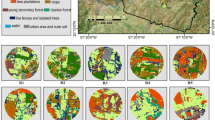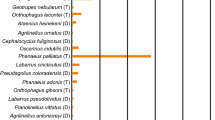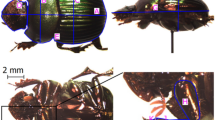Abstract
There is growing interest in evaluating the impact that management intensity of agroecosystems has on animal communities and their ecological functions. Dung beetles are a highly used focal taxon for assessing the effects of anthropogenic disturbances and management practices on biodiversity. In the Lacandona rainforest region in southern Mexico, we quantified several metrics of the dung beetle community (number of species, number of individuals, total biomass, mean beetle size) and four of their ecological functions (dung removal, soil excavation, seed dispersal, seed exhumation) in conserved rainforest and three agroforestry systems with different management intensities: rustic cocoa, polyculture cocoa, and rubber monoculture. We also assessed the correlation between dung removal and the other functions, as well as the relationships between functions and community metrics. Land-use type affected the dung beetle communities as well as their functions, with negative effects on response variables in the most intensely managed agroecosystems (polyculture cocoa and rubber). Rustic cocoa had values similar to those of the conserved forest for all functions and community metrics, except the mean number of species per trap. Dung removal was correlated with the other ecological functions. The mean number of species per trap was significantly associated with all four functions. In our study region rustic cocoa plantations favor the maintenance of a high proportion of dung beetle species and maintain their ecological functions. Our findings corroborate that agroecosystems with less intense management may contribute to buffering the effects of landscape homogenization caused by more intensely managed agroecosystems, such as rubber plantations.



Similar content being viewed by others

References
Alkorta I, Albizu I, Garbisu C (2003) Biodiversity and agroecosystems. Biodivers Conserv 12:2521–2522
Altieri MA (2004) Globally important indigenous agricultural heritage systems (GIAHS): Extent, significance, and implications for development. FAO, Rome
Andresen E (2002) Dung beetles in a Central Amazonian rainforest and their ecological role as secondary seed dispersers. Ecol Entomol 27:257–270
Arellano L, Favila ME, Huerta C (2005) Diversity of dung and carrion beetles in a disturbed Mexican tropical montane cloud forest and on shade coffee plantations. Biodivers Conserv 14:601–615
Audino LD, Louzada J, Comita L (2014) Dung beetles as indicators of tropical forest restoration success: is it possible to recover species and functional diversity? Biol Conserv 169:248–257
Bang HS, Lee JH, Kwon OS, Na YE, Jang YS, Kim WH (2005) Effects of paracoprid dung beetles (Coleoptera: Scarabaeidae) on the growth of pasture herbage and on the underlying soil. Appl Soil Ecol 29:165–177
Bates D, Mächler M, Bolker B, Walker S, Christensen RHB, Singmann H, Dai B, Grothendieck G, Green P (2017) Linear mixed-effects models using ‘Eigen’ and S4. R package version 1.1–14
Braga RF, Korasaki V, Andresen E, Louzada J (2013) Dung beetle community and functions along a habitat-disturbance gradient in the Amazon: a rapid assessment of ecological functions associated to biodiversity. PLoS ONE 8:e57786
Broström G (2017) Generalized linear models with clustering description binomial and poisson regression for clustered data, fixed and random effects with bootstrapping. R package version 1.0.2
Chao A, Jost L (2012) Coverage-based rarefaction and extrapolation: standardizing samples by completeness rather than size. Ecology 93:2533–2547
Cuarón AD (2000) Effects of land-cover changes on mammals in a Neotropical region: a modeling approach. Conserv Biol 14:1676–1692
Culot L, Bovy E, Vaz-de-Mello FZ, Guevara R, Galetti M (2013) Selective defaunation affects dung beetle communities in continuous Atlantic rainforest. Biol Conserv 163:79–89
Dangles O, Carpio C, Woodward G (2012) Size-dependent species removal impairs ecosystem functioning in a large-scale tropical field experiment. Ecology 93:2615–2625
De Jong BH, Ochoa-Gaona S, Castillo-Santiago MA, Ramírez-Marcial N, Cairns MA (2000) Carbon flux and patterns of land-use/land-cover change in the Selva Lacandona: Mexico. Ambio 29:504–511
De Rosario-Martinez H, Fox J, R Core Team (2015) Post-hoc interaction analysis. Description analysis of terms in linear, generalized and mixed linear models, on the basis of multiple comparisons of factor contrasts. R package version 0.2-1
Edwards FA, Finan J, Graham LK, Larsen TH, Wilcove DS, Hsu WW, Chey VK, Hamer KC (2017) The impact of logging roads on dung beetle assemblages in a tropical rainforest reserve. Biol Conserv 205:85–92
Estrada A, Raboy BE, Oliveira LC (2012) Agroecosystems and primate conservation in the tropics: a review. Am J Primatol 74:696–711
Fox J, Weisberg S, Adler D, et al (2013) Companion to applied regression. R package version 2.1-5
França F, Louzada J, Korasaki V, Griffiths H, Silveira JM, Barlow J (2016) Do space-for-time assessments underestimate the impacts of logging on tropical biodiversity? An Amazonian case study using dung beetles. J Appl Ecol 53:1098–1105
Frank K, Hülsmann M, Assmann T, Schmitt T, Blüthgen N (2017) Land use affects dung beetle communities and their ecosystem service in forests and grasslands. Agr Ecosyst Environ 243:114–122
Gardner TA, Barlow J, Araujo IS et al (2008) The cost-effectiveness of biodiversity surveys in tropical forests. Ecol Lett 11:139–150
Gill B (1991) Dung beetles in tropical American forests. In: Hanski I, Cambefort Y (eds) Dung beetle ecology. Princeton University Press, Princeton, pp 211–229
Giraldo C, Escobar F, Chara JD, Calle Z (2011) The adoption of silvopastoral systems promotes the recovery of ecological processes regulated by dung beetles in the Colombian Andes. Insect Conserv Divers 4:115–122
Gray CL, Slade EM, Mann DJ, Lewis OT (2014) Do riparian reserves support dung beetle biodiversity and ecosystem services in oil palm-dominated tropical landscapes? Ecol Evol 4:1049–1060
Gregory N, Gómez A, Maria T, Oliveira FDS, Nichols E (2014) Big dung beetles dig deeper: trait-based consequences for faecal parasite transmission. Int J Parasitol 45:101–105
Griffiths HM, Louzada J, Bardgett RD, Beiroz W, França F, Tregidgo D, Barlow J (2015) Biodiversity and environmental context predict dung beetle-mediated seed dispersal in a tropical forest field experiment. Ecology 96:1607–1619
Griffiths HM, Bardgett RD, Louzada J, Barlow J (2016) The value of trophic interactions for ecosystem function: dung beetle communities influence seed burial and seedling recruitment in tropical forests. Proc R Soc B 283:20161634. https://doi.org/10.1098/rspb.2016.1634
Häger A, Otárola MF, Stuhlmacher MF, Castillo RA, Arias AC (2015) Effects of management and landscape composition on the diversity and structure of tree species assemblages in coffee agroforests. Agr Ecosyst Environ 199:43–51
Halffter G, Arellano L (2002) Response of dung beetle diversity to human-induced changes in a tropical landscape. Biotropica 34:144–154
Halffter G, Edmonds WD (1982) The nesting behavior of dung beetles (Scarabaeinae). An ecological and evolutive approach. Instituto de Ecología A.C, Mexico City
Holdridge R (1967) Life zone ecology. Tropical Science Center, San José
Horgan FG (2005) Effects of deforestation on diversity, biomass and function of dung beetles on the eastern slopes of the Peruvian Andes. For Ecol Manage 216:117–133
Hosaka T, Niino M, Kon M, Ochi T, Yamada T, Fletcher C, Okuda T (2014) Effects of logging road networks on the ecological functions of dung beetles in Peninsular Malaysia. For Ecol Manage 326:18–24
Hothorn T, Bretz F, Westfall P, Heiberger RM, Schuetzenmeister A, Scheibe S (2017) Simultaneous inference in general parametric models. R package version 1.4-7
Hsieh TC, Ma KH, Chao A (2016) iNEXT: iNterpolation and EXTrapolation for species diversity. R package version 2.0.12. http://chao.stat.nthu.edu.tw/blog/software-download/
Johnson MD, Kellermann JL, Stercho AM (2010) Pest reduction services by birds in shade and sun coffee in Jamaica. Anim Conserv 13:140–147
Kudavidanage EP, Qie L, Lee JSH (2012) Linking biodiversity and ecosystem functioning of dung beetles in South and Southeast Asian tropical rainforests. Raffles Bull Zool 25:141–154
Laurance WF, Useche DC (2009) Environmental synergisms and extinctions of tropical species. Conserv Biol 23:1427–1437
Lefcheck JS, Byrnes JEK, Isbell F et al (2015) Biodiversity enhances ecosystem multifunctionality across trophic levels and habitats. Nat Commun 6:6936. https://doi.org/10.1038/ncomms7936
Loreau M, Naeem S, Inchausti P (eds) (2002) Biodiversity and ecosystem functioning: synthesis and perspectives. Oxford University Press, London
Manning P, Slade EM, Beynon SA, Lewis OT (2016) Functionally rich dung beetle assemblages are required to provide multiple ecosystem services. Agr Ecosyst Environ 218:87–94
Menéndez R, Webb P, Orwin KH (2016) Complementarity of dung beetle species with different fuctional behaviours influence dung-soil carbon cycling. Soil Biol Biochem 92:142–148
Montoya-Molina S, Giraldo-Echeverri C, Montoya-Lerma J, Chará J, Escobar F, Calle Z (2016) Land sharing versus land sparing in the dry Caribbean lowlands: a dung beetles’ perspective. Appl Soil Ecol 98:204–212
Neita JC, Escobar F (2012) The potential value of agroforestry to dung beetle diversity in the wet tropical forests of the Pacific lowlands of Colombia. Agrofor Syst 8:121–131
Nichols ES, Gardner TA (2011) Dung beetles as a candidate study taxon in applied biodiversity conservation research. In: Simmons LW, Ridsdill-Smith TJ (eds) Ecology and evolution of dung beetles. Wiley, Chichester, pp 267–291
Nichols E, Larsen T, Spector S, Davis AL, Escobar F, Favila M, Vulinec K (2007) Dung beetle response to tropical forest modification and fragmentation: a quantitative literature review and meta-analysis. Biol Conserv 137:1–19
Nichols E, Spector S, Louzada J, Larsen T, Amezquita S, Favila ME, Network TSR (2008) Ecological functions and ecosystem services provided by Scarabaeinae dung beetles. Biol Conserv 141:1461–1474
Nichols E, Uriarte M, Peres CA, Louzada J, Braga RF, Schiffler G, Whaldener E, Spector SH (2013) Human-induced trophic cascades along the fecal detritus pathway. PLoS ONE 8:e75819
Noriega JA, Hortal J, Azcárate FM et al (2017) Research trends in ecosystem services provided by insects. Basic Appl Ecol. https://doi.org/10.1016/j.baae.2017.09.006
Oksanen J, Kindt R, Legendre P, O’Hara B (2007) Vegan: community ecology package. R package version 1.8-5. http://cran.r-project.org/
Otieno NE, Gichuki N, Farwig N, Kiboi S (2011) The role of farm structure on bird assemblages around a Kenyan tropical rainforest. Afr J Ecol 49:410–417
Penttilä A, Slade EM, Simojoki A, Riutta T, Minkkinen K, Roslin T (2013) Quantifying beetle-mediated effects on gas fluxes from dung pats. PLoS ONE 8:e71454
Perfecto I, Vandermeer J (2008) Biodiversity conservation in tropical agroecosystems: a new paradigm. Ann N Y Acad Sci 1134:173–200
Pineda E, Moreno C, Escobar F, Halffter G (2005) Biodiversity in cloud forest and shade coffee: analysis of three indicator groups. Conserv Biol 19:400–410
Ponce Santizo G (2008) Dispersión secundaria de semillas defecadas por monos en hábitats con diferentes niveles de perturbación. Dissertation, Universidad Nacional Autónoma de México
R Core Team (2013) R: A language and environment for statistical computing. R Foundation or Statistical Computing, Vienna, Austria. www.R-project.org/
Ripley B, Venables B, Bates DM, Hornik K, Gebhardt A, Firth D (2017) Support functions and datasets for Venables and Ripley’s MASS. R package version 7.3-47
Sánchez-de-Jesús HA, Arroyo-Rodríguez V, Andresen E, Escobar F (2016) Forest loss and matrix composition are the major drivers shaping dung beetle assemblages in a fragmented rainforest. Lands Ecol 31:843–854
Santos-Heredia C, Andresen E (2014) Upward movement of buried seeds: another ecological role of dung beetles promoting seedling establishment. J Trop Ecol 30:409–417
Slade EM, Mann DJ, Villanueva JF, Lewis OT (2007) Experimental evidence for the effects of dung beetle functional group richness and composition on ecosystem function in a tropical forest. J Anim Ecol 76:1094–1104
Slade EM, Mann DJ, Lewis OT (2011) Biodiversity and ecosystem function of tropical forest dung beetles under contrasting logging regimes. Biol Conserv 144:166–174
Slade EM, Riutta T, Roslin T, Tuomisto HL (2016a) The role of dung beetles in reducing greenhouse gas emissions from cattle farming. Sci Rep 6:18140
Slade EM, Roslin T, Santalahti M, Bell T (2016b) Disentangling the ‘brown world’ faecal–detritus interaction web: dung beetle effects on soil microbial properties. Oikos 125:629–635
Tisovec KC, Cassano CR, Boubli JP, Pardini R (2014) Mixed-species groups of marmosets and tamarins across a gradient of agroforestry intensification. Biotropica 46:248–255
Tscharntke T, Clough Y, Bhagwat SA, Buchori D, Faust H, Hertel D, Hölscher D, Juhrbandt J, Kessler M, Perfecto I, Scherber C, Schroth G, Veldkamp E, Wanger T (2011) Multifunctional shade-tree management in tropical agroforestry landscapes – A review. J App Ecol 48:619–629
Vandermeer JH, Perfecto I (2007) The agricultural matrix and a future paradigm for conservation. Conserv Biol 21:274–277
Vandermeer JH, Perfecto I, Philpott SM, Chappell MJ (2008) Reenfocando la conservación en el paisaje: La importancia de la matriz. In: Harvey CA, Saénz JC (eds) Evaluación y conservación de biodiversidad en paisajes fragmentados en Mesoamérica. INBio, Santo Domingo de Heredia, pp 75–104
Williams-Guillén K, Perfecto I (2010) Effects of agricultural intensification on the assemblage of leaf-nosed bats (Phyllostomidae) in a coffee landscape in Chiapas, Mexico. Biotropica 42:605–613
Zárate DA, Andresen E, Estrada A, Serio-Silva JC (2014) Black howler monkey (Alouatta pigra) activity, foraging and seed dispersal patterns in shaded cocoa plantations versus rainforest in southern Mexico. Am J Primatol 76:890–899
Zermeño-Hernández I, Pingarroni A, Martínez-Ramos M (2016) Agricultural land-use diversity and forest regeneration potential in human-modified tropical landscapes. Agr Ecosyst Environ 230:210–220
Acknowledgements
We are thankful to SEMARNAT and CONANP for issuing the necessary permits (SGPA/DGVS/03075/13; Oficio No. REBIMA/009/12) and facilitating access to the Montes Azules Biosphere Reserve. For assistance in the field, we thank Rafael Lombera, Miguel Miranda, Isaías Lombera, and Isidro López Lira. We thank one associate editor, three anonymous reviewers and Mary Ann Hall for thoughtful comments and editorial corrections that helped us improve the manuscript. We thank Pedro Luna for his valuable help and advice in data analyses. We are thankful to CONACyT for providing a graduate study fellowship to CS-H (245258) and the Industrial University of Santander’s for a post-doctoral fellowship to CS-H. Research was funded through grants to EA by CONACyT (SEP-CONACyT 2010-152884) and DGAPA-UNAM (PAPIIT, IN-207711).
Author information
Authors and Affiliations
Contributions
CS-H, EA and FE formulated the research idea. CS-H and EA designed the experiments, with contributions from FE. CS-H and DAZ conducted all fieldwork. CS-H, EA and FE analyzed the data and wrote the manuscript.
Corresponding author
Ethics declarations
Conflict of interest
The authors declare that they have no conflict of interest.
Additional information
Communicated by David Hawksworth.
This article belongs to the Topical Collection: Forest and plantation biodiversity.
Electronic supplementary material
Below is the link to the electronic supplementary material.
Rights and permissions
About this article
Cite this article
Santos-Heredia, C., Andresen, E., Zárate, D.A. et al. Dung beetles and their ecological functions in three agroforestry systems in the Lacandona rainforest of Mexico. Biodivers Conserv 27, 2379–2394 (2018). https://doi.org/10.1007/s10531-018-1542-x
Received:
Revised:
Accepted:
Published:
Issue Date:
DOI: https://doi.org/10.1007/s10531-018-1542-x



